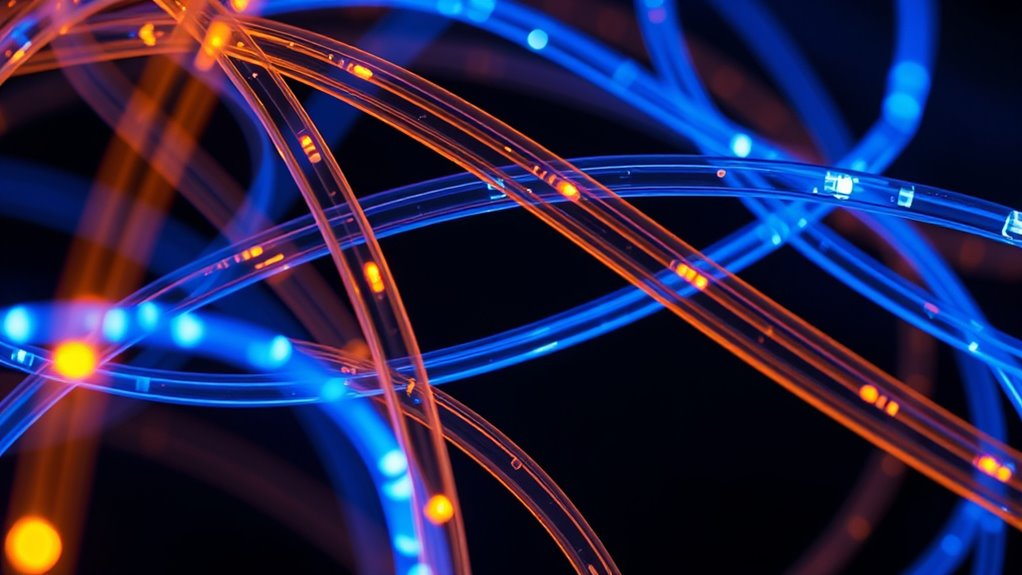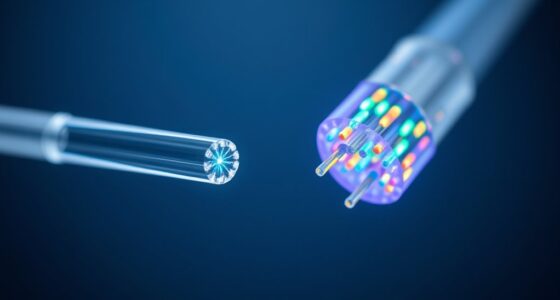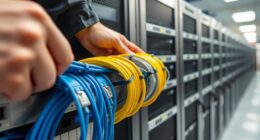Imagine a tiny highway where light races through with barely a bump—this is how fiber cables work. You might wonder how such a small strand can carry so much data over long distances. The secret lies in the way light bounces inside the core, staying confined and efficient. To truly understand this remarkable process, it’s important to explore the principles behind total internal reflection and the role of the core and cladding.
Key Takeaways
- Light travels through fiber cables via total internal reflection, bouncing within the core without escaping.
- The core has a higher refractive index than the cladding to facilitate internal reflection.
- When light hits the core-cladding boundary at an angle above the critical angle, it reflects entirely inside the core.
- Precise control of refractive indices and fiber geometry ensures minimal signal loss over long distances.
- This mechanism allows high-speed, long-distance data transmission essential for modern communication networks.

The travel of light in fiber cables is fundamental to modern telecommunications, enabling high-speed data transmission over long distances. When you send information through a fiber optic cable, you’re essentially guiding light through a tiny, flexible glass or plastic strand. The core principle that makes this possible is total internal reflection, a phenomenon that keeps the light bouncing within the core without escaping. To understand this better, you need to grasp the concept of the refractive index. The refractive index measures how much light slows down as it passes through a material. In fiber optics, the core has a higher refractive index than the surrounding cladding, which is vital for total internal reflection to occur.
When light enters the fiber at a specific angle, it hits the boundary between the core and the cladding at an angle greater than the critical angle. This critical angle depends on the refractive indices of both materials. Because the core’s refractive index is higher, the light reflects entirely within the core instead of passing into the cladding. This continuous reflection allows the light signal to travel long distances with minimal loss. The process is remarkably efficient, especially because the difference in refractive indices is carefully engineered. If the core’s refractive index is too close to that of the cladding, the total internal reflection becomes less effective, and signal loss increases.
You can think of total internal reflection as a perfect mirror within the fiber, bouncing the light back and forth along its length without any escape. This principle is what makes fiber optics superior to traditional copper cables for data transmission. The angles at which light hits the boundary are vital; if they are too shallow, some light can escape, weakening the signal. That’s why fiber cables are designed with precise control of the refractive indices and core geometry—so the light remains confined and travels efficiently.
Additionally, the refractive index difference between core and cladding plays a crucial role in maintaining signal integrity and minimizing attenuation over long distances. Engineers carefully select materials to optimize this difference, ensuring maximum internal reflection and minimal signal degradation. As a result, data can be transmitted over hundreds or even thousands of miles with high fidelity. Understanding how total internal reflection and refractive index work together reveals why fiber optic technology is so effective and why it forms the backbone of global communication networks.
Frequently Asked Questions
How Does Fiber Cable Bend Without Losing Signal?
When you bend a fiber cable, you need to keep the bend radius within the recommended limits to prevent signal loss. If you bend it too sharply, light can escape or scatter, weakening the signal. By maintaining an appropriate bend radius, you guarantee the light stays trapped inside the core, allowing data to flow smoothly without interruption. Proper handling and installation are key to avoiding signal loss during bends.
What Materials Are Used in Fiber Optic Core?
Imagine a city’s bustling network where data zips through fiber optic cables. The fiber core is typically made of silica glass, chosen for its high transparency and low attenuation. Its core material properties include excellent optical clarity and durability. These qualities guarantee efficient light transmission, even over long distances. The fiber core composition’s strength and refractive index are vital for maintaining signal integrity while bending or twisting the cable without losing data.
How Are Signals Amplified in Long-Distance Fiber Optics?
To amplify signals in long-distance fiber optics, you use signal boosting with amplification technology like optical amplifiers. These devices are placed at intervals along the fiber to strengthen weak signals without converting them to electrical signals. As the light travels through the fiber, the amplifiers boost its strength, ensuring your data stays clear and fast over great distances. This process helps maintain high-quality communication without interruptions.
Can Fiber Cables Be Repaired if Damaged?
Think of fiber cables like glass swords—beautiful but fragile. When damaged, fiber repair is possible but complex, often requiring specialized technicians to splice or replace sections. While fiber cables are designed for durability, they can still suffer from cracks or breaks. Proper fiber repair restores their integrity, ensuring continued signal transmission. However, prevention through careful handling is always better than repair after damage occurs.
What Are the Safety Precautions for Handling Fiber Optics?
When handling fiber optics, always wear protective gloves and eye protection to prevent injuries from sharp fibers and tiny glass shards. Work in a well-ventilated area and avoid touching the fiber ends directly to prevent irritation. Use proper tools and disposal methods for damaged fibers. Remember, safety first—careful handling reduces risks and keeps you safe while maintaining the integrity of the fiber optic cables.
Conclusion
So, now you know how light zigzags effortlessly through fiber cables, staying confined like a superstar on a endless stage. This incredible process, driven by total internal reflection, makes fiber optics the backbone of our digital world. Without this marvel, your streaming, browsing, and communication would slow to a crawl. Truly, without fiber optics, the internet would be as slow as a snail in a marathon. It’s a tiny marvel fueling our massive digital universe.









